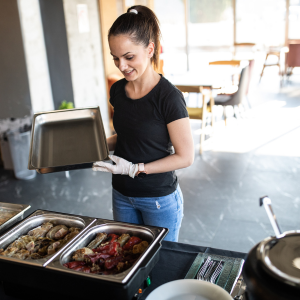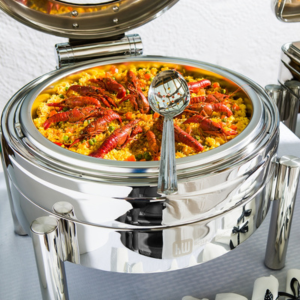Hosting an upcoming event or starting a catering business? Then, mastering the humble chafing dish is crucial in your journey. Chafing dishes help keep your food warm, boosting taste and presentation. But using them may seem daunting if you're new to the game.
Don't fret; we're here to guide you through the ins and outs of this essential party tool. From setup to effective use and crucial dos and don'ts, this comprehensive guide will ensure you serve your food like a seasoned pro. So, let's plunge into the world of chafing dishes and enhance your serving skills!
Anatomy Of A Chafing Dish

A chafing dish is a serving dish that uses indirect heat to keep food warm. It typically consists of a pan or dish that holds the food, placed over a separate container filled with a heat source, such as a sterno fuel can or electric heating element. Chafing dishes are commonly used at buffets, catered events, or gatherings where maintaining the temperature of prepared food is important. They're versatile and come in various styles and sizes, making them convenient for serving a wide range of dishes while keeping them at the desired temperature.
- Frame: The frame is the foundational support for the entire chafing dish setup. It's designed to hold the water and food pans securely while providing stability on a serving surface. The sturdiness of the frame ensures the dish remains steady, preventing any accidental spills or mishaps during service.
- Water Pan: Positioned above the heat source, the pan is filled with hot water to generate steam, the primary heat source for keeping the food warm. This indirect heat maintains the food's temperature without risking overheating or burning, ensuring a consistent and gentle warmth throughout the serving duration.
- Food Pan: Nestled within the water pan, the food pan is where the actual dishes to be served are placed. This is where the magic happens, as the steam from the water pan gently warms the food, preserving its moisture and flavors. The size and depth of the food pan can vary, allowing for flexible serving quantities and arrangements.
- Cover/Lid: The cover or lid plays a crucial role in regulating heat and preserving the food's integrity. It acts as a barrier against external elements, retaining warmth and moisture within the dish. Additionally, it prevents contaminants from entering the food while allowing for easy access when serving.
- Fuel Holder/Burner: This component provides the necessary heat to warm the water in the water pan. It's usually filled with chafing fuel, such as gel or liquid, which burns steadily to maintain the desired temperature. The fuel holder's placement and design ensure a consistent heat supply throughout the event, essential for sustaining the food's optimal serving temperature.
Each part of the chafing dish collaborates harmoniously to create an environment that keeps food at an ideal serving temperature, preserving its taste, texture, and overall quality. Understanding the functionality of these components enables precise setup and efficient use, guaranteeing a delightful dining experience for your guests.
Types Of Chafing Dishes

Explore the world of culinary presentation and food service efficiency with the diverse range of chafing dishes available. From timeless classics to innovative modern designs, discover the various types of chafing dishes that cater to your specific needs and elevate your dining experience. Delve into the nuances of functionality, aesthetics, and practicality as we delve into the distinct types of chafing dishes designed to enhance your culinary endeavors.
Stainless Steel Chafing Dishes
These are revered for their durability, making them versatile for diverse events like weddings or corporate gatherings. Their sturdy build ensures longevity, enduring frequent use and transport without compromising quality. With a sleek appearance, they effortlessly blend into formal settings, adding a touch of sophistication to upscale events. These dishes are dishwasher-safe and stain-resistant, simplifying post-event cleanup and making them a top choice for professionals orchestrating stylish events.
Chafing Dishes With Glass Lids
They offer an elegant touch, providing a sneak peek of the dishes within without needing to open them. This visual allure enhances the ambiance, perfect for high-end restaurants or themed parties, captivating guests' curiosity and anticipation. Their transparency adds a gourmet flair, enticing guests and elevating the dining experience. Ideal for settings where aesthetics take precedence, these dishes shine in sophisticated gatherings and culinary showcases.
Disposable Chafing Dishes
These are the go-to solutions for casual affairs where cleanup efficiency matters. Lightweight and convenient, they're perfect for picnics or informal gatherings, eliminating post-event cleaning hassle. Their one-time use eliminates dishwashing, making them particularly popular for events in locations lacking cleaning facilities. These dishes prioritize convenience over reusability, reducing post-event cleanup stress and becoming indispensable for various casual occasions.
How To Set Up And Use A Chafing Dish

Setting up and using a chafing dish is relatively straightforward. Here's a step-by-step guide:
- Place The Frame: Begin by setting the frame on a stable, flat surface that can withstand heat. Ensure it's level to prevent any accidents or spills during use.
- Position The Water Pan: Fit the water pan securely into the frame. Add hot water to the pan, filling it about halfway. Avoid overfilling, as this can lead to spills when inserting the food pan.
- Light The Chafing Fuel: Before placing the food pan, carefully light the chafing fuel. Use long-reach lighters or matches, and follow the manufacturer's instructions for safe lighting. Always do this away from any flammable materials.
- Place The Food Pan: Once the water in the pan starts to heat up from the chafing fuel, position the food pan securely on top of the water pan. Transfer preheated food into the food pan. Ensure the lid fits snugly to retain heat.
- Cover And Monitor: Cover the chafing dish with its lid to maintain a consistent temperature. Regularly check the flame to ensure it continues burning evenly and monitor the overall stability of the setup.
Serving And Refilling

When it comes to serving and refilling a chafing dish, here are some key points to consider:
- Using Utensils: Employ appropriate serving utensils like tongs, ladles, or serving spoons to serve food from the chafing dish. Avoid using hands or utensils that aren't designed for serving hot food.
- Monitoring Food Levels: Keep an eye on the food levels, ensuring the food pan doesn’t go empty. Refill the food pan as needed to maintain a consistent supply for your guests.
- Maintaining Water Levels: Check the water level in the water pan periodically. Refill it if necessary to prevent it from drying out. Keeping an eye on this ensures that the food stays heated evenly.
- Handling Refills: When refilling the chafing dish with food or water, be cautious to avoid spillage or splashing. Use appropriate containers and tools to add food or water without disturbing the ongoing service.
- Guest Assistance: If guests are serving themselves, provide clear guidance on how to use the chafing dish safely. Ensure they know how to handle the serving utensils and the hot surfaces to prevent accidents.
By meticulously following these steps and maintaining vigilance during the setup, serving, and refilling processes, you can ensure the efficient and safe operation of your chafing dish throughout the event, providing a delightful dining experience for your guests.
Do's And Don'ts Of Using A Chafing Dish
Following these dos and don'ts will help ensure the safe and effective use of chafing dishes while maintaining the food's quality.

Do's
Here are some important do's when using a chafing dish:
- Preheat Food: Always ensure that the food you place in the pan is adequately heated beforehand. This helps maintain consistent temperatures and prevents any drop in heat when transferring food to the chafing dish.
- Regularly Check Water Level: Keep an eye on the water level in the water pan throughout the event. Refill it as needed to prevent it from drying out. Adequate water ensures the food stays heated without burning.
- Use Proper Serving Utensils: Employ designated serving utensils like tongs, ladles, or spoons when serving from the chafing dish. This prevents contamination and ensures safe handling of hot food.
- Monitor Food Temperature: Continuously monitor the temperature of the food in the chafing dish to ensure it remains within the safe and optimal serving range. Use food thermometers if necessary.
Don'ts
Here are some important don'ts when using a chafing dish:
- Overfill The Water Pan: Avoid filling the water pan to the brim, as this can lead to spillage when placing or removing the food pan. Aim for a level that allows sufficient steam without the risk of splashing.
- Stir Food Excessively: Refrain from excessive food stirring in the chafing dish. This can cause heat loss and disrupt the even distribution of heat, potentially leading to unevenly heated food.
- Use Improper Fuel Or Heat Source: Never use inappropriate fuel or heat sources for the chafing dish. Stick to the recommended fuel type and avoid improvising with materials not designed for this purpose, as it can be hazardous.
- Forget To Monitor Flaming Fuel: Keep an eye on the chafing fuel or heat source throughout the event. Ensure it burns steadily and evenly without flare-ups or fluctuations affecting the food's temperature.
Serve Food In Style At Catered Events

Using a chafing dish may seem complex at first, but it becomes a straightforward task with a clear understanding of its components, different types, and mindful use. Using a chafing dish revolves around careful setup, continuous monitoring, and appropriate handling. This comprehensive guide is designed to help first-time and experienced hosts deliver a warm and gourmet food experience to their guests.
It's now time to take your entertaining skills up a notch. Embrace the elegance and functionality that a chafing dish brings to the table. Enjoy the complimenting smiles from your contented guests as they savor the warm, delicious food served just right, all thanks to your newfound art of chafing dishes. So, get ready to bask in the glory of a successful event!






